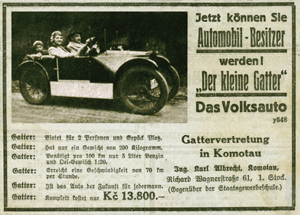|

In German
|
The
Gatter Volksautomobiles
Gatter
Cars ran on the roads of Bohemia and the adjacent German territories
in the 1920s and 1930s. With a price of just 1000 Reichsmark they
were the most inexpensive automobiles in Europe of the time. Their
creator Willibald Gatter was born in 1896 in Hühnerwasser, then
Austo-Hungary, today Kurivody (Ralsko) in the Czech Republic. The
Austro-Daimler engineer was inspired by the idea to produce small
and inexpensive cars, affordable also to the working class. In the
city of Aussig (Ústí nad Labem), Gatter built from 1926 to 1929
his model "Schreckenstein" ("Grosser Gatter"),
an elegant four-seater with swing axles, praised by the press of
those days as the "perfect model for an European Car." Between 1930
and 1936 Willibald Gatter produced the "Kleine Gatter"
(Small Gatter) in the city of Reichstadt (Zakupy) in about 1650
units and seven different models. The cars were equipped with two-stroke
engines, had 10 PS and reached a speed of 80km/h. They were ideal
for the mountainous terrain of Northern Bohemia. Since the Gatter
car cost little more than a motorbike, the press soon awarded it
the name of Volksauto or Volkswagen, meaning "Peoples Car".
 |
|
The
Nazis would use this term when creating their Volkswagen Works
in Wolksburg in 1937 that produced the VW-Beetles we all know
so well. It was in his "Kleine Gatter" that Willibald
Gatter won countless prizes in the mountain races of the 1930s.
In 1931, he even challended world champion Rudolf Caracciola
in the Schauinsland race. Amongst Gatter's greatest successes
were gold medals for the "Grosser Bergpreis von Deutschland"
(German Mountain Grand Prix), the "Tatra Sternfahrt",
the "Böhmisches Bergrennen", the "Schwarzwald
Zielfahrt", the "Riesen- and Isergebirgsfahrt".
When an economic crisis hit Bohemia in the mid 1930s, it was
the low and middle classes that suffered most and Gatter's clientele
were soon impoverished. By 1936 the Autowerk Gatter had to close
down.
|
At
the end of World War II the Gatter family were refugees in Western
Germany. Here Willibald Gatter intended to reproduce his 1930s success.
In the early 1950s he again built the prototype for an affordable
small car, the "Gatter-Mini". But lack of investment capital
as well as consumer preference for large American-style cars meant
that this model never got beyond the prototype stage. Today probably
only one Gatter Car survives. It is a 1932 four-seater model with
reverse gear and chain drive.
|
|

